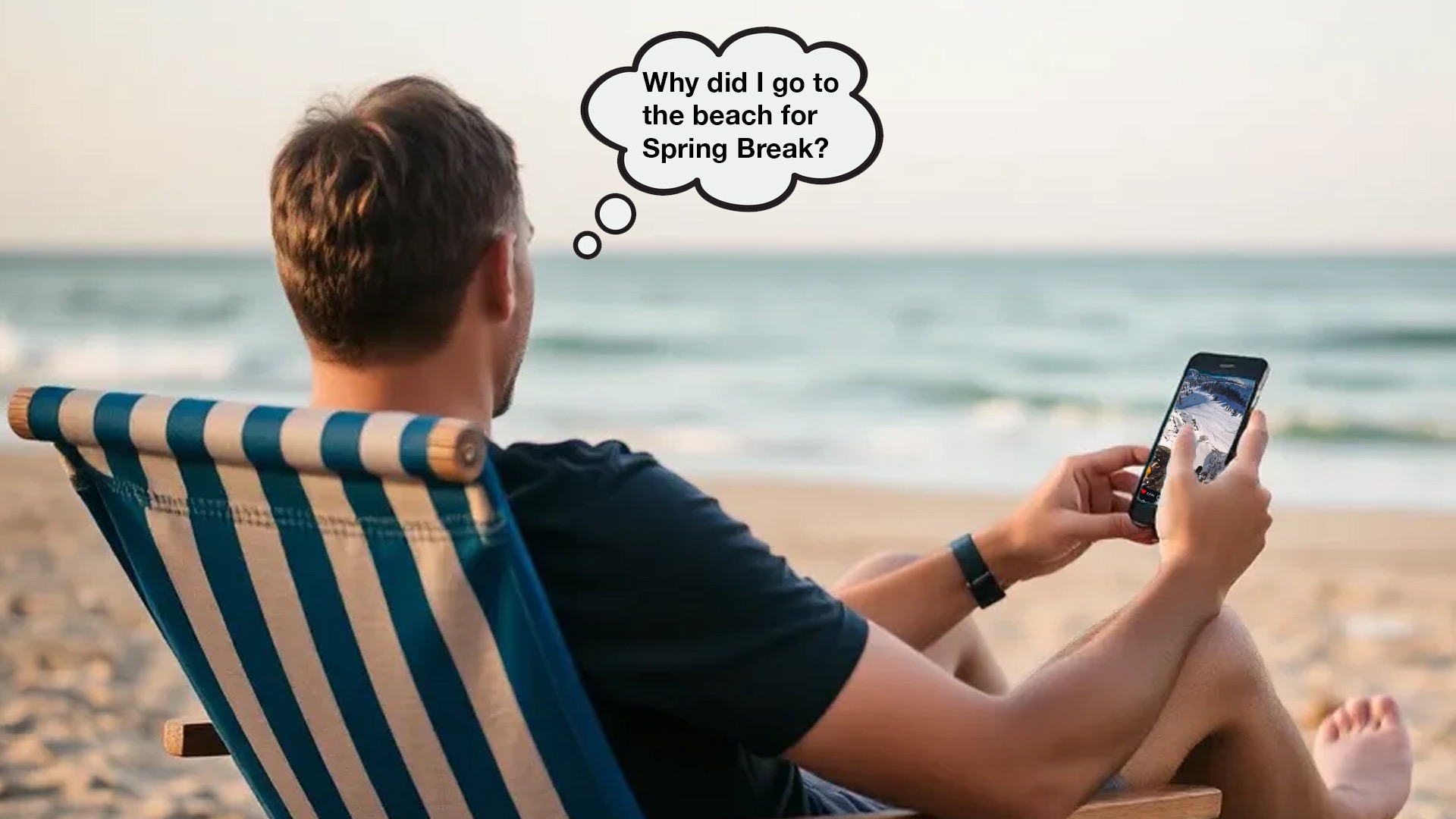 |
| The "Fear of Missing Out" affects brain chemistry. | Photo: SnowBrains |
I'm now two weeks into recovering from an ankle injury and I've caught myself doing something counterproductive: scrolling through Instagram incessantly. While I'm currently mastering the delicate art of navigating stairs on crutches, my feed is full of friends skiing powder lines, standing on sunlit summits, and linking perfect turns. Not only am I missing out—I'm hyper-aware of what I'm currently missing.
- Related: The Brain Science Behind Flow States
How the Brain Creates FOMO
Fear of Missing Out isn’t just emotional—it’s structural. Neuroimaging research shows that people who score high on FOMO tend to have reduced cortical thickness in a brain region called the precuneus. This part of the brain, nestled within the Default Mode Network (DMN), is heavily involved in memory, self-reflection, and social cognition. It’s what helps us imagine scenes, reflect on our relationships, and picture what others might be doing.When you’re watching your friends get face shots in deep pow while you’re laid up with an injury or stuck at work, your brain’s DMN starts firing. You don’t just see the scene—you mentally simulate being there. You imagine what it feels like, sounds like, even smells like. And then you compare that imagined experience to your current reality: being stuck inside.
FOMO also overlaps with the brain’s reward system. Normally, dopamine—a neurotransmitter associated with pleasure and motivation—helps reinforce rewarding behavior. But it also works through something called reward prediction. If you expect something good to happen and it doesn’t, dopamine levels crash. That’s called a negative prediction error.
In the context of FOMO, when you see others having an experience you want, your brain calculates that you’re missing out on a reward. The result? A mix of frustration, craving, and emotional discomfort. This cycle can make you keep checking your phone or social media feed, even when you know it won’t make you feel better.
Why Social Media Makes It Worse
Social media platforms are designed to hook attention and deliver quick dopamine hits. Fast-scrolling apps like TikTok and Instagram amplify this by showing bite-sized content that’s emotionally engaging. This pattern conditions the brain to seek out constant updates—and to feel anxiety when those updates seem better than our current situation. The term “TikTok brain” has been coined to describe this hyper-stimulation of neural reward pathways. For injured skiers, this can be especially brutal—we’re not just missing out, we’re being shown exactly what we’re missing in real time.So if you’re injured or sidelined, and you keep watching ski content, your brain isn’t just reacting—it’s being trained to keep reacting. It’s easy to fall into a loop of checking, comparing, and feeling left out. Not everyone experiences FOMO the same way, either. Research shows that people with stronger emotional regulation and better connectivity between the brain’s control centers and the DMN are better equipped to manage it. Those with less emotional regulation tend to be more vulnerable.
There are gender differences, too. A Spanish study found that women tend to score higher on social media addiction and “phone obsession,” often tied to emotional connection, while men scored higher on internet gaming-related behaviors. These findings suggest gendered differences in how social stimuli are processed and what kinds of digital FOMO we’re more prone to.
 |
| Social media has a way of turning every powder day you miss into a full-blown mental highlight reel. | Photo: SnowBrains |
Injury and Isolation Can Intensify It
For skiers, missing a season or even just a few ripping storm cycles can feel like missing a part of your identity. Skiing isn’t just an activity—it’s often a form of community, self-expression, and mental health maintenance. Being cut off from that doesn’t just hurt physically. It changes your sense of connection and belonging. That isolation makes the social comparison loop of FOMO even more potent. The brain, looking for connection and stimulation, turns to digital sources. But those sources can backfire, triggering even more comparison and dissatisfaction.How to Manage the Spiral
Understanding the brain science behind FOMO can help reduce its power. Here are a few strategies supported by research: - Mindfulness meditation: Helps calm the Default Mode Network and reduce obsessive thoughts. - Cognitive Behavioral Therapy (CBT) techniques: Challenge distorted thinking patterns that fuel social comparison. - Digital boundaries: Take structured breaks from social media to break the dopamine-checking cycle. - Real-world interaction: Talking to friends in person or journaling your thoughts can ground your perspective.The Bigger Picture
FOMO isn’t a personal failing—it’s a byproduct of how our brains evolved interacting with modern technology, which is currently ongoing. Our neural wiring, designed for in-person social groups, is being constantly triggered by digital platforms that weren’t built with mental health in mind. The neuroscience of FOMO also raises ethical concerns for tech design. If digital platforms are designed to tap into the brain’s reward system and capitalize on our fear of missing out, there's a real argument for making those systems more responsible. Researchers suggest that dopamine-triggering features, such as endless scrolls or social comparison cues, should be implemented by social media companies with caution—especially for users more prone to compulsive behavior.Understanding the neurological roots of FOMO won’t make it disappear, but it can help us navigate it. When you find yourself feeling left out or anxious about what you’re missing, it helps to pause. Recognize the neural systems at play. You’re not weak. You’re human. And sometimes, the best move for your mental health isn’t catching up on everyone else’s adventures—it’s stepping away for a bit and focusing on your own. Even if sometimes, like in my case, that means just healing, resting, and waiting for next season.
 |
| Scroll. Cringe. Repeat. The FOMO loop always starts with one innocent tap. POV: Miles Clark at Palisades Tahoe, CA, on an epic powder day in March 2025. | Photo: SnowBrains |
No comments:
Post a Comment